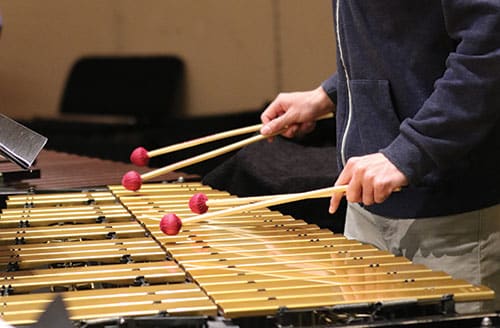
Conscientious instrumental teachers help students choose proper reeds, mouthpieces, strings, and bows to match players’ physical dimensions, playing experience, and musical needs. Percussionists make the same choices about sticks and mallets to perform their best, and they are faced with many more options for many more instruments. This article offers guidelines for choosing sticks and mallets to match the most common instruments in school programs, as well as insights to help directors apply those choices to other instruments.
Snare Drum
Perhaps the most common percussion instrument throughout school programs, the snare drum requires sticks that match the student’s arm and hand size and strength, and that provide solid response from the drum or pad. For both single and bounce strokes, the sticks should rebound naturally and require minimal physical force from the player. A common mistake made by many students is using sticks that are too small, requiring considerable effort with little reward, especially when playing doubles and buzzes. Make sure students start with sticks specifically designed for concert snare drum. They will be able to use these sticks for other instruments like concert tom-toms and field drum also.
Drum Set
Many students will shift from snare drum to drum set when needed and may try to use their snare drumsticks to play it. While the drum set does include snare drum, it also typically requires repetitive playing on the hi-hat and cymbals. Smaller sticks work much better for this part of the job. The smaller bead and lighter weight provide a more articulate sound on cymbal surfaces and reduce the washy snowball effect of the strokes.
The snare drum’s role within the drum set is typically less involved than in the concert setting, so the benefit of smaller sticks on the cymbal surfaces far outweighs the challenge of reduced rebound and response. In certain situations, such as Broadway-style musicals or concert medleys, the drum set player may be able to quickly alternate between snare drumsticks and drum set sticks to enjoy the benefits of each during unique sections of the performance. For example, if an up-tempo two-beat toe tapper is followed by an ominous military march, the player may have time to switch from smaller sticks to larger ones and make the most of both approaches to the instrument.
Timpani
Generally, a range of felt-covered mallets will provide all possible articulations while setting these large instruments into maximum vibration for a satisfying sound. Timpani should generally sound full and resonant; the felt mallets help to create lots of pitch and body while minimizing the attack. Smaller, harder mallets will produce articulate sounds for staccato passages, while larger, softer mallets will produce legato sounds for sustained notes and rolls. Pay close attention to the condition of the felt as timpani mallets age. If they contain bald or heavily worn spots, rewrap or replace them as soon as possible.
Bass Drum and Suspended Cymbal
High-quality mallets for the concert bass drum are similar to timpani mallets, with a wooden shaft and felt-covered head, but are much larger and heavier. The weight of the mallet head and length of the shaft help players get a big, full sound from the instrument. Consider keeping at least one very large mallet for playing loud single impacts and two identical smaller mallets for rolling sustained notes.
Players can use multiple options for approaching the suspended cymbal. Characteristically full notes and rolls work best with soft mallets specifically manufactured for the instrument or yarn-wrapped marimba mallets. Especially for rolls, the mallets should produce no attack sound but plenty of resonance. In other situations, players might use thin wooden sticks, triangle beaters, small metal rakes, brushes, or even coins to strike or scrape the instrument for effects indicated by the composer or arranger. Encourage players to be creative about finding the best sound in these unique situations. Sometimes the best mallet choice is something not designed for musical performance.
Keyboards
Keyboard instruments require several different pairs or sets of mallets due to the wide variety of bar sizes, materials, and densities. Players can use small, hard plastic or brass mallets for orchestra bells (glockenspiel). Any-thing softer will produce a thin, superficial sound and could also damage the mallets. For xylophone, move to slightly softer plastic. Manufacturers will often call these medium, medium-hard, or medium-soft, and some will even designate them specifically as xylophone mallets. For vibraphone and marimba, yarn-wrapped mallets are generally the best choice. If possible, buy a set of four for each instrument. Note that shaft and head dimensions and materials are usually different for these two instruments, so avoid having players use the same mallets for both. One specific note: rattan and birch shafts feel very different when playing. Have students try both to see what feels best to them before purchasing. Crotales respond best to small brass mallets, though triangle beaters can serve as a viable substitute. Chimes sound best with rawhide or plastic hammers. Maintaining all of these mallets for their specific purpose and instrument is crucial for producing quality sounds across the keyboards.
Accessories
Percussionists should play the triangle with high-quality metal beaters and should have matched pairs of several different diameters or beaters with a tapered diameter for dynamic and articulation changes. The woodblock works best with medium or medium-hard rubber mallets. Softer yarn-wrapped mallets or harder sticks can be used with caution in some situations, but these options can produce weak sounds and damaged woodblocks, respectively. Tam-tams and gongs sound best with large, heavy yarn-wrapped mallets designed specifically for these instruments. As with all mallets, be sure to have a matching pair so that players can roll effectively for sustained notes.
Combo Mallets
Various combination mallets are commercially available and quite helpful. The most common options contain two different heads on opposite ends of a shaft: timpani/snare, glockenspiel/snare, and timpani/glockenspiel, for example. Other combinations are also available and, perhaps most important, you and your students can create any combination desired with a bit of ingenuity and engineering. These innovative mallets can save the day when a student needs to play, for example, a long timpani roll followed by several quick triangle notes. Having a bit of hard metal on the butt end of the timpani mallets helps students shift swiftly and directly from one instrument to the other.
Marching Percussion
Players can use the same general guidelines for marching percussion instruments, with a few slight but important distinctions. For marching instruments, snare drumsticks are generally larger, bass drum mallets are smaller and denser, and timpani and keyboard mallets are harder. These differences help the instruments project more on the field at a distance. Also, quad or quint players may want to use a pair of disc-shaped sticks designed specifically for these instruments, although marching snare sticks also work.
Maintenance
Maintenance or replacement of mallets and sticks is crucial to success for percussion students. Even the best percussion instruments will sound only as good as the condition of the implements used to play them. Consider the parallels to brass, winds, and strings: Damaged mouthpieces, reeds, and bows simply cannot produce high-quality music. Listen carefully during rehearsals, check your mallet inventory frequently, and encourage students to do the same to help you catch mallets in need of repair or replacement. Take care of mallet problems as soon as possible, to avoid additional damage to them and to the instruments.
Final Thoughts
The percussion family contains more instruments than what I have described here. My hope is that these recommendations are helpful for approaching the most common instruments in school programs and for providing insights as to how teachers might apply these concepts to others. Choosing the right mallets and sticks will maintain the health of your instruments and produce the best music. Trust your musical ear and encourage students to do the same when making mallet choices. Take the time to review and replenish your mallet inventory frequently. Finally, a little creativity goes a long way toward solving musical problems through mallet adaptation and even invention. Getting just the right sound is always worth it.
Photos by Kirby Fong






